(Read the Previous Part of the Journey)
There were only 3 compartments headed by a diesel engine in the small train. The first & the last one was regular non-AC coaches and the middle one was air conditioned. When I entered my designated coach F1, there two more families already occupying the first few rows of the compartment. Though it can accommodate 18 persons there were only 8 including me.
The first family headed by a grey-haired gentleman had his wife and two children. The father, in his early forties, was busy adjusting the oversized items of luggage into the small cabinet made just beside the toilet of the coach. The two children of his family both boys under the teenage were playing on his mobile phone. Their mother, proud of her sons being thought in English medium schools back home, was trying to feed them banana and bread by repeatedly insisting in broken English. The sons, however, were not paying much interest to their mother’s request. I felt they are not really hungry and the mother also was not very keen in feeding them – she was getting the pleasure of letting the world know that her sons are into English medium schools – a precious achievement for most Bengali parents. The other family who had more aged parents and a young lady in her late teens were less noisy. The father was busy with the sports page of a Bengali newspaper and the daughter with the phone. The mother was trying to start a conversation with her counterpart. When I entered the coach almost all of them gave me a suspicious look. I felt the level of suspicion was higher among the second family because they had a grown-up daughter. The wife of Family No. 1 put the bread in the newspaper kept on the seat and adjusted her dupatta – which was already in perfect position. The father of the Family No 2, lowering her newspaper stared at me and asked me a single syllable question – ‘F1?’. As if, I have intentionally come to this coach following his daughter. I ignored his vibe and simply answered ‘Yes’ and went straight up to the last row and occupied a window seat. Though I had a seat no written on my ticket I decided not to follow that.

The journey started after a few minutes. It was extremely hot and there was too much of sun entering through the wide windows. The windows did not have any grills and the shutters were aluminium rolling shutter which always keeps half of the window closed. The slow speed of the train also did not bring much air into it. I was surprised to see the two young boys wearing heavy sweaters. They were complaining about that but their mother, over-concerned about the health of her brilliant English medium sons kept on saying – ‘No. it will be cool’. I could feel the pain of the young men. Soon, the competition of general knowledge started – first among the ladies and soon the men joined. One of them – I could not understand from the back who – had past experience of Darjeeling and he was extremely interested in delivering everything at once. The other family had been to Ooty in past and they were trying to compare each and everything with their experience from there. I thought it would be too much knowledge in too short a time but tried to enjoy it – it was going to be a long journey and a bit of entertainment was needed.
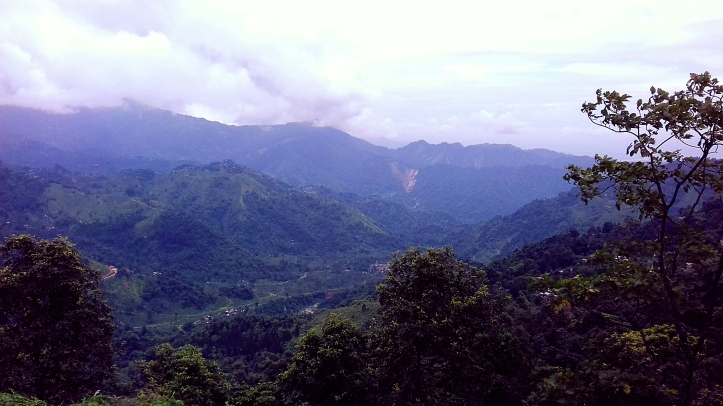
The last time I rode in the toy train – there were not much of display of the world heritage tag but this time I saw there are plenty of signages, display boards all around the platform and also in the route marking the glory of the Darjeeling Himalayan Railway. (Read the History of Darjeeling Himalayan Railway) The first part of the journey was through the busy roads of Siliguri. It was morning so the pressure of traffic on road was high. The little girls in their white school uniforms were waiting for the bus and when they saw the training passing they gladly waved at us. The markets in many places extended over the track of the railway line and the train had to make repeated stops to allow them to move aside. Suddenly there was a long stoppage in the middle of nowhere. The train kept on whistling but there was nothing in front. I saw a few vendors from the roadside shops were smiling seeing the front of the train. I extended my head out of the window a saw a giant bull slowly moving across the track.
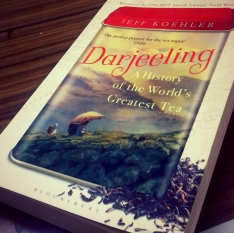
They train made two quick stops – at Siliguri Town and Siliguri Junction. Siliguri Junction was the original starting point of this train which got extended up to New Jalpaiguri in 1964. The 7.5 kilometres journey from NJP to Siliguri Jn took almost an hour and seemed that my co-passengers have lost all their energy by then. Making quite a long stoppage for almost half an hour the train started again – the view from the window changed drastically. The poorly planned buildings are now replaced with greens – Forests & Tea Gardens were seen from both sides. Once it crossed the Panchai River the green increased with a very few buildings. Though the Hill Cart road was there, it will actually be there for the entire journey, on one side of the road, the amount of honking of cars was much less now. Soon, there were tea gardens on both sides of the track. It looked beautiful as the small tea bushes covered the entire ground and long sal trees covered the horizon. These tea gardens, however, are not part of the actual lot producing authentic Darjeeling Tea – these are Dooars tea gardens. This started a new set of discussions inside the compartment. One of the gentlemen was quick to point to the authority and administration. One of the ladies made a short comparison of the fare they paid and what are the facilities they deserved. I took a sigh and concentrated on my book – Darjeeling – A History of the World’s Greatest Tea.

It took some time through the lovely forest on both sides before the actual ascend was felt. The Sukna Station (Elv – 533 ft) was the starting point from where the rail took a mountain route. The route after the Sukna Station is extremely panoramic with a dense forest on both sides of the track. The train slowly moved along the edge of the ridge making twists and turns. Between Sukna & Rongtong (Elv – 1404 ft) the rail rises for almost a thousand feet covering a distance of less than 8 kilometres. Rongtong is a small station in the middle of lower Himalayan forests. The journey between Rongtong & Chunabhatti is even more charming. The hills become even more beautiful and the ridge on the sides become more visible and attractive. From here the Sepoy Dhara Tea Garden can be clearly seen. On this route, Sepoy Dhara is the first of the tea gardens producing Darjeeling Tea and is part of the list that has right to use the G.I. (Geographic Indication) tag for Darjeeling Tea on their product. In a straight line distance, Rongtong & Chunabatti is less than a kilometre but on rail & road, they are separated by 8 kilometres journey and the first Zigzag crossing. There was a huge roar of dissatisfaction inside my compartment as people felt the train was moving backwards. The complaining gentleman, in fact, made an analysis and a conclusion on what problem has occurred with the locomotive. He, however, was silent after a few minutes.
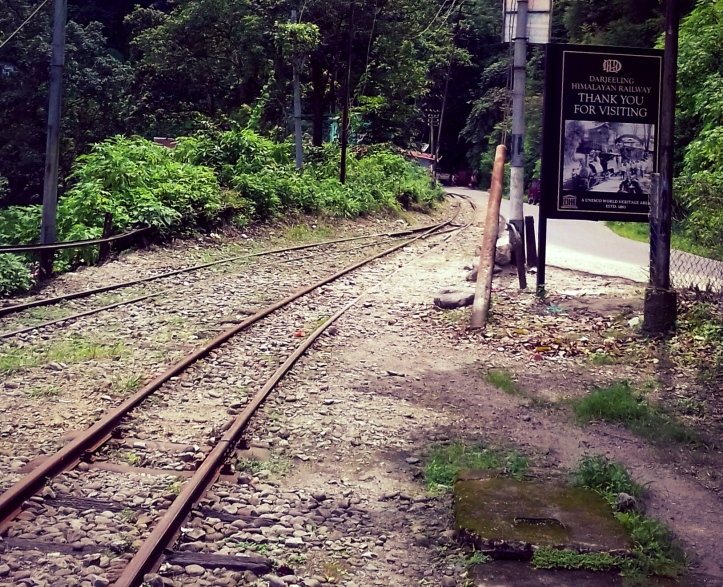
Zigzag Crossing or simply Z-Crossing is an engineering marvel that has been used in this railway track. It was a big challenge in front of the engineers to negotiate the tough terrains of the mountains as there was not enough length to construct a smooth slope. They were able to find this solution where the railway line is laid in a zigzag form with each of the three arms making upward slope from the previous. The car – moving forward-backwards-forward rise to a formidable height despite covering much horizontal distance. The Darjeeling Himalayan Railway was the first mountain railway in India and it was constructed without using any heavy engineering – like tunnels or bridges. This forced the engineers to come up with innovative solutions to negotiate the terrain. Just like Z-Crossings, Loop is another excellent way they have used where the track makes a full circle and rising to an elevation.
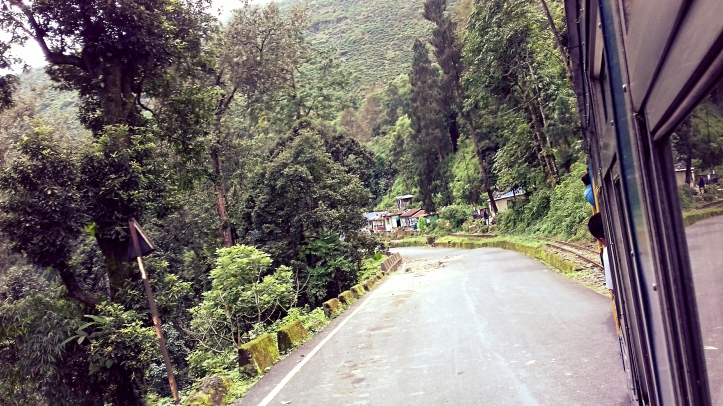
Soon after the first Z-cross, the train entered the first loop just before reaching the Chunabhatti Station. This, however, was originally the third loop but the first two were removed over time.

From Chunabatti to Tindharia (Elv – 2822 ft), it was another six kilometres journey through the beautiful jungles. This small stretch has two Z-curves in a very short span and this makes the journey even more interesting. In almost an hours time, the train was in Tindharia. This was the first stretch of DHR to be completed in March 1880. Tindharia is also famous for the workshop of DHR which is located just before the main station. The train stopped for almost an hour for a lunch break for the passengers and the support staffs. I was surprised to see a gang of almost ten people travelled on the train who were there to deal with any emergency in the route. They said, the locomotives and the compartments are quite old and have a tendency to break down suddenly. That’s why a big crew is always travelling on the train. My co-passengers were elated to get a break for lunch and rushed to the tea shop in the platform where packed lunches are sold. I also decided to get one because the train was already behind schedule and there was no guarantee of its performance in higher terrains. The Mother of two was quick to start feeding her sons who were still wearing the heavy sweaters. This time I noticed even the mother has also put on a sweater herself. Though Tindharia is at a higher elevation, it was still very warm outside and inside. The silence that covered them for last few hours was gone and they again started chatting among themselves – again about their experience with foods served on their previous journies.
It was almost 1 o’clock when the train finally resumed its journey. The next destination was the Kurseong. Though Gayabari & Mahanadi are two small stations that come on the route the train did not stop in any as there were no passengers standing on the platforms. It was nearly three hours the train took to cover the twenty kilometres journey between Tindharia and Kurseong.
Kurseong is a beautiful city on the slopes of the Eastern Himalaya and is home to some of the best producers of Darjeeling Tea – Ambootia, Makaibari, Castleton are some of the most celebrated tea estates of the region. Joseph Dalton, an eminent British botanist, while travelling to these areas in April 1848 wrote about Kurseong;
“From Kurseong a very steep zigzag leads up the mountain, through a magnificent forest of chestnut, walnut, oaks and laurels. It is difficult to cncieve a grander mass of vegetation; – the straight shafts of the timber trees shooting aloft, some naked and clean, with grey, pale or brown bark; others literally clothed for yards with a continuos garment of epiphytes, one mass of blossoms, especially the white Orchids, which bloom in a profuse manner, whitenning their trunks like snow”
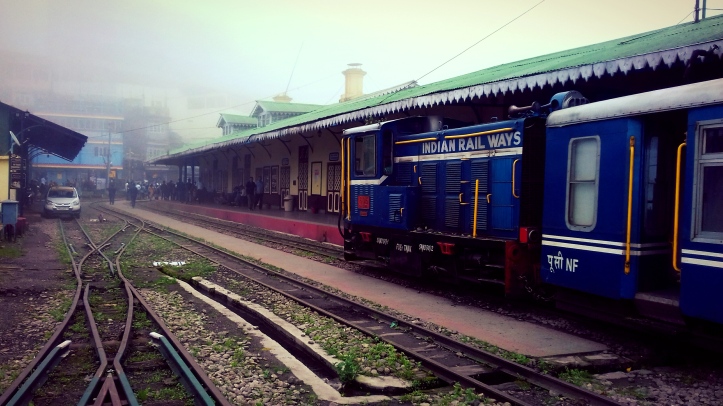
This was written when the settlement was hardly there. Darjeeling, the city, was less than a decade old and tea was only being planted experimentally at places. The scene even after 160 years has not changed much except for the fact that a lot of forests has been replaced with tea gardens. There has been a change is the vista & economy of Kurseong. Here again, little school children were seen returning to home. The tea plucker was also seen returning from their job – their big baskets hanging from the head could easily identify them.

The train needed some maintenance here. An entire crew were busy fitting some part under the AC Compartment. I got down from the coach to loosen the joints and could see both the gentlemen eagerly observing the activities down there. The smaller ones were also keen to get down but their mother would never allow to do them such a heroic. She repeatedly told them that the train might start any moment and that could cause a big accident to the budding jewels of their family. One of the gentlemen finally broke the silence and asked me –
‘You from Kolkata?’
‘Yes’ I replied
He smiled and said – ‘We are too’
‘Oh great’ I said.
I thought he felt that I am not really interested in making a friend of him but he still tried to continue the conversation.
‘Going to Darjeeling?’
Now that he knew I was from Kolkata he could have started speaking in Bengali but he was confident about his English Skills and kept on.
‘Yes. and You?’
‘We are also going to Darjeeling, We did not get a booking during the summer vacation of my son’s school. So, we decided to go now. I have come here before…’
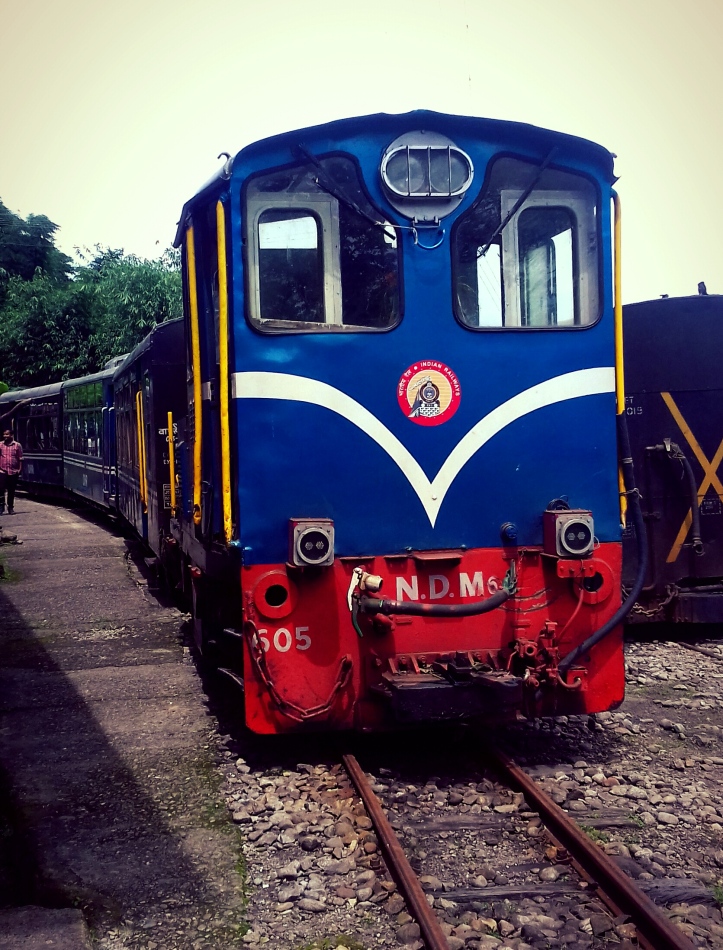
He was about to pass on the experiences he has gathered in his previous encounters but to my rescue, the guard of our train blew the whistle. I was saved for the time. I smiled at him and quickly went inside our compartment. I heard a few whispers among them that passed the information that I was also from Kolkata. It was before the train reached Kurseong that the vision was covered with a thick cloud. The train was passing through that and I could also feel the moisture in my hand. This is one thing I love the most about Darjeeling in Monsoon. It is a lovely feeling to walk through the clouds. At times, it was impossible to see anything beyond a meter or so. The train kept on playing with the could and kept on moving along the curly hill tracks. The monsoon has brought a real freshness in the plants in the slopes and also brought life to the waterfalls. These are small springs that get hydrated only in this season but their dynamism brings a different kind of joy to the onlookers. I couldn’t count how many of these small waterfalls were there in our route. The journey between Kurseong and Ghum was almost 25 kilometres and covered an elevation of 2600 feet.
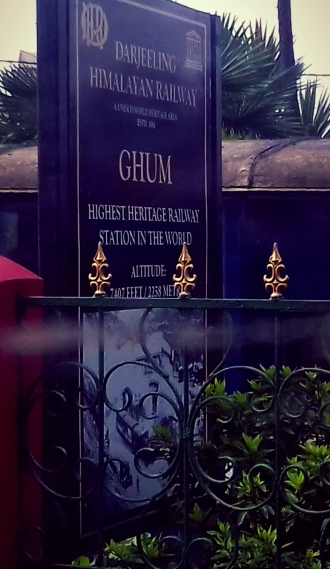
It was almost five when the train finally reached Ghum. In between two small stations – Tung and Sonada were passed but the train did not stop at any of those as there was nobody to board or alight. Ghum is Asia’s highest railway station built at a height of 7407 feet. The place was full of clouds through which the station building was hardly seen. On the first floor of Ghum Station is a beautiful railway museum dedicated to the DHR’s legacy and glory. I really felt these people should give a break for half n hour there so that the passengers may have a look at that but that was not the case. Within a minute the train started to complete the final stage of the journey. Darjeeling station (Elv – 6812 ft) is at a lower elevation than Ghum and the train descends slowly. Right outside the Ghum Station a giant monastery was seen which is famous as Ghum Monastery. after a few minutes, the most famous of the loops – Batasia Loop appeared. Batasia Loop has a war memorial dedicated to the Gorkha Soldiers – the high obelisk and the statue of the soldier looks fabulous in the misty environment.
The train finally reached its destination at around 6 o’clock in the evening – 3 hours behind its schedule and the tired souls slowly got out of the compartments. The families, while dealing with the heavy pieces of luggage, were cursing the railway authority for not running the train properly. They were in discussion among themselves to find a medium to take them to their hotels. I decided to walk up the hill – its a known route for me up the Laden La road and Gandhi Road to the Mall.
The weather was good- the cloud was gone. It was a lovely walk up the shopping streets – through most of the shops did not have any buyer because of the off-season and the shopkeepers were enjoying chatting among themselves – some of them holding a cup of tea. It did not take half an hour to reach the Chowrasta Mall and I decided to take a short break there. The life at Mall is always to charming – horses moving around, children playing with bubbles, a few kids practising their bike skills and some practising their dancing skills on the stages. It was world cup time and the top of the Mall was covered with flags of the participating nations. A giant screen towards the Observatory Hill showed the highlights of a previous match. I wish I could stay a little longer but I had to move on – it was getting late for me to check-in, get fresh and come out for dinner.
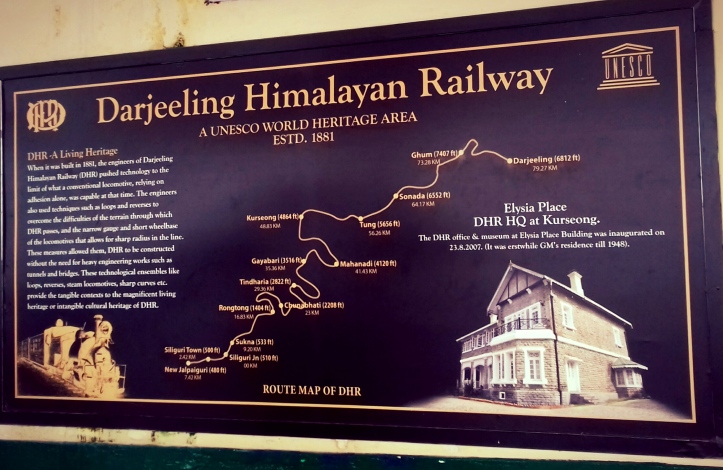
![]()







The way of writing is just amazing..😊
LikeLiked by 3 people
Thanks a lot.
LikeLike
Very much impressive…. 💖
LikeLiked by 4 people
Thank you so much
LikeLike
🌿🌹
LikeLiked by 1 person
I love trains and train rides! The Darjeeling Himalayan railway is so famous, and for good reason. I would love to explore the mountainside by train. This looks like a fantastic trip.
LikeLiked by 2 people
What an adventure you had! The Darjeeling Himalayan Railway looks wonderful, especially because I enjoy train journeys. I’ve only seen photos of the green tea gardens you have in India, so can imagine how pretty the landscape is. I like your way of storytelling too, so fun to read!
LikeLiked by 3 people
Thanks for reading.
LikeLike
Love the story! You are very good and telling stories 🙂 I felt like I was literally there 🙂 it sounds like just a nice train ride, though. I would love to do it, someday :):):) who knows… Keep it up!
LikeLiked by 3 people
Great post, I loved your writing!
And I recently went to Darjeeling, your post made me want to relive my Darjeeling days.
-Malvika
(www.teacupsandlipsticks.com)
LikeLiked by 3 people
[…] a corner of the Mall and watching people around you without getting bored. I was tired after a long Toy Train Journey but lying on the bed of my hotel room does not feel like as refreshing as seating in the […]
LikeLike
I love history like this. When I was in NZ with my parents we also did an historic train ride 🙂 I wouldn’t mind doing this train ride. Who knows one day! 🙂
LikeLiked by 3 people
Thanks for sharing. What a beautiful adventure! We visited India not too long again and loved the many cross country train journeys we took. Unfortunately, we never got to do the toy train to Darjeeling. Now I really wish I had!
LikeLiked by 3 people
A beautiful post that brought back loads of memories. I have travelled in this train twice and what an experience. It’s a beauty and the journey through the hills is simply amazing. It can get hot as you mentioned when the sun comes up. The scenery is simply amazing and that feel of going in the past. Some great history attached as well.
LikeLiked by 3 people
I love train journeys in India! I have travelled in the Toy Train that goes to Simla and it’s an equally beautiful journey so while reading your experience about the Darjeeling train, I was reminded about similar landscapes that I’ve seen in Simla as well. The Toy Train is slow, so much that sometimes people even get off the train and on again as it moves along. Journeys through hills and forests in a slow-moving train like this are very appealing to me!
LikeLiked by 3 people
I totally enjoyed reading this post. The way you have narrated is no less than a Bollywood script. It intrigued my curiosity and as and how I proceded reading this post I felt I was virtually there. The train journey is worth the experience and stunning view. I will definitely plan a trip soonest. Thanks for sharing it so beautifully.
LikeLiked by 3 people
What a historic ride! I love that encounters with other travellers informed your journey, it sounds incredible. Plus, your description of Darjeeling in the monsoon was beautiful!
LikeLiked by 3 people
You have a real talent for storytelling in your writing! I like the sound of these toy trains, and could imagine myself there, especially with the help of your photos! Kursong sounds really pretty, and clearly the place to go for tea!
LikeLiked by 3 people
I love scenic train rides! Your blog is more like reading a story than a post. I like it!
LikeLiked by 3 people
Thank you so much..
LikeLike
Long train rides are special especially when passing through scenic routes. It is also the best time to read a travel book. I long wanted to see the Himalayan part of India and this post makes me want to go there even more. The journey itself sounds exciting.
LikeLiked by 3 people
Love your storytelling. I love train journeys and this particular train trip has been on my wishlist for a very long time. Love how much detail you gave, you should write a book!
LikeLiked by 3 people
Wow – very detailed post! Never been to India, but i feel like I would put this on my itinerary when I do finally make it over there.
And from the comments on this post, doesn’t sound like I’m the only one excited to go here!
LikeLiked by 3 people
What a wonderful ride among misty mountains and beside the road. This train ride is even shown in many famous Bollywood movies. I have not done this train ride but it is high on my list, as it looks like a fairy tale ride among mountains. Ghum Station museum also looks an interesting place to visit here.
LikeLiked by 3 people
Such a beautiful journey! I love the mountain and the landscape along the road. The information about Zigzag Crossing is interesting as well. Enjoy reading your writing cause I can imagine myself taking the ride.
LikeLiked by 3 people
Train in a good idea and also cheap way to go around. How i wish we have a decent train system in the Philippines, so that we can explore many places. Reading your post is like a virtual reality!
LikeLiked by 2 people
This sounds like a very interesting travel day! Thank you for sharing your experience and these photos.
LikeLiked by 3 people
Nothing fascinates me more than travelling by train! How the train meanders through the valleys, hills and huge fields…or should I say, the middle of nowhere is definitely very intriguing!
LikeLiked by 3 people
Sounds like a beautiful adventure. I am sure you all had a blast!
LikeLiked by 3 people
What a lovely story, and the train ride sounds like it’s a great way to travel. I enjoy trains, you get such a fantastic view of the natural scenery.
LikeLiked by 3 people